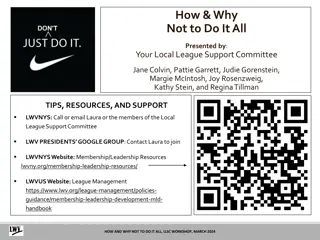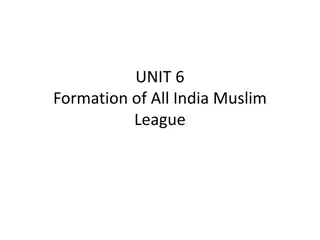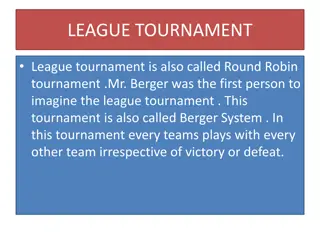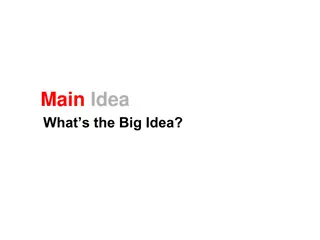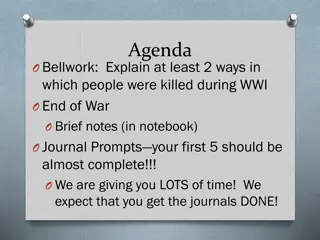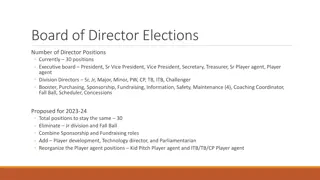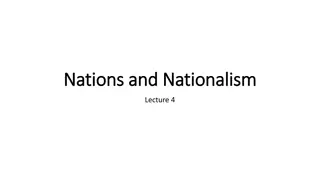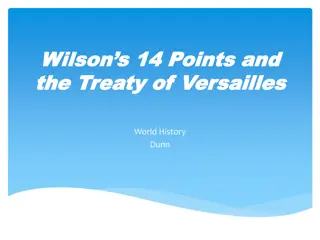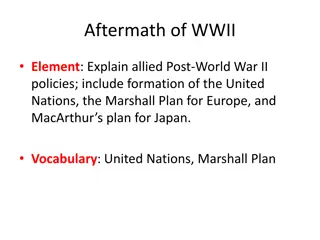Understanding the League of Nations: Good Idea or Not?
The League of Nations, established after WWI, aimed to promote peace through collective security and cooperation among nations. It faced challenges due to limited powers and the attitudes of key member countries. Despite its intentions, the League ultimately struggled to prevent future conflicts.
Download Presentation

Please find below an Image/Link to download the presentation.
The content on the website is provided AS IS for your information and personal use only. It may not be sold, licensed, or shared on other websites without obtaining consent from the author. Download presentation by click this link. If you encounter any issues during the download, it is possible that the publisher has removed the file from their server.
E N D
Presentation Transcript
Tuesday, 23 July 2024 LESSON TITLE: Was the League of Nations a good idea? 1. Thinking back to your previous history lessons. What key words can you make related to slavery/empire? 2. How many points can you get!! Using the words you have formed. Create a sentence.
Was the League of Nations a good idea? Assess whether the League of Nations was a good idea? Explain why the League of Nations was started Describe how the League of Nations was set up Mastering Securing Developing
League of Nations The League of Nations was an international organisation. It was set up as part of the Treaty of Versailles. It was the idea of the US president Woodrow Wilson he thought the League would help to stop future wars. There were 42 countries in the League when it began in 1919.
League of Nations The aim of the league was to: - To be united and strong enough to discourage any nation from using force as a way to solve disputes - To provide a place to discuss international disputes and work them out peacefully. - To encourage countries to co-operate, especially in business and trade. - To encourage disarmament by nations. - To improve living and working conditions for people around the world. By sticking together, the nations of the world would have protection and help from each other this was called collective security
Task: Use the information provided (next slide) to complete the following table to sum up the positive and negative aspects of the League. Key issues Membership of the League How decisions were made in the League Positive view Negative View Powers of the League Explain why the attitude of Britain and France towards the League might be a problem.
The council met five times a year or when there was an emergency. It had some temporary members elected by the Assembly and four permanent members Britain, France, Italy and Japan. The real power in the League lay with these four. Each permanent member could veto (stop) any action by the League. In any crisis, the Council took all the important decisions. The League of Nations The Assembly was the League s parliament. It met once a year. It voted on issues such as the budget (spending) of the League, or letting new members in. Decisions had to be unanimous (every member had to agree). The League had a number of commissioners, or committees, to tackle international problems such as helping refugees or improving health. The League was run by a permanent Secretariat (staff of office workers) How could the League make a country do what it wanted? It had three main powers. It could use; Moral condemnation criticising the actions of the aggressor (the nation which was attacking another nation) Economic sanctions cutting off important supplies like oil. - Armed force using force against the aggressor. The Court of International Justice helped to settle disputes between countries. The court would listen to both sides and then make a decision, just like any ordinary court or law. - - Was the League powerful? Most people and governments wanted the League to succeed. However, the League had some weaknesses right from the start: Its way of working for example, the Assembly met only once a year and every vote had to be unanimous. This meant that reaching decisions was a slow process. Its membership the USA did not join; Germany and the USSR only joined much later; Britain and France were both weakened by the First World War. Britain and France had their own priorities: Britain wanted to protect its empire France worried about another attack Who belonged to the League? The League began with 42 nations, by 1939, there were over 50 members. But some powerful nations left the League or never joined. For example, Germany joined in 1926 and left in 1933, Japan left in 1933, Italy left in 1937. The USA never joined! The League may have been President Wilson s big idea, but he could not get the rest of the USA to agree. The US Congress (Parliament) did not want the USA to get involved in sorting out the problems of the rest of the world. This became known as isolationism. This was a real setback for the League. Everybody knew that the League needed the USA s money and troops so that it could work effectively. from Germany They often put these concerns ahead of the League s priorities.
Was the League of Nations a good idea? Complete the following in full sentences 1.What was the League of Nations? 2. How were decisions made in the League? 3. Why was the USA not a member of the League? Why was the USA not being a member a problem?
Task: Explain why the League of Nations was set up. One reason why the League of Nations was set up was.. This was because.. This was supposed to help Therefore, the League of Nations was set up because The League of Nations was a good idea. How far do you agree? Overall I think the League was a good/bad idea. I think this because.. The evidence to support this is Although, some people may disagree with me because.. However, I still think ____ because..
Task: In your book, write a sentence that summarises you opinion on whether the League was a good idea or doomed to fail. Be prepared to share your opinion! Great idea! Doomed to fail!








